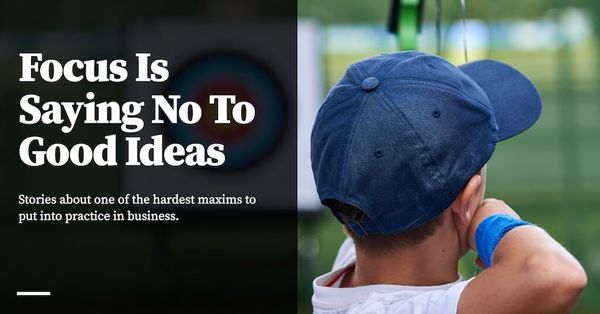There’s a famous saying, often attributed to Steve Jobs, that goes “focus is saying no to good ideas.” The more experience that I have with business, the more I appreciate just how true this is.
The only problem with this advice is that it’s trite — it sounds obvious; people don’t take it seriously; it’s a cliché. But it really isn’t any of those things, not if you’re actually trying to put it to practice. One of the more interesting things about focus is that you can see it in good operators, if you know how to look. But it happens to also be really difficult to do.
Instead of articulating a fully-fleshed out theory of focus, I want to do something different here. I’m going to tell you a handful of stories. This should do more to illustrate the nature of focus in business than anything else that I can say. Let’s get started.
Cohort Based Courses
Let’s say that you’re like me, you run a decently successful blog or you have a reasonably-engaged audience. What do you do next? One obvious, highly lucrative approach is to create and sell a cohort based course, teaching your audience some valuable skill that you have. Cohort based courses are both a worthy product and the quickest way to generate revenue from your knowledge — one of the realities of the info-product world is something that entrepreneur Patrick McKenzie calls the ‘tyranny of the form factor’, which is that digital products are sold within a particular set of price ranges:
- Ebooks: $19 ~ $49
- Ebooks + Video: $99 ~ $149
- Video courses: $250 - $500+
- Live courses: $250 ~ $999+++
And so since live courses are at the very top of the price list, it would seem like a good idea to package my knowledge in that form. Indeed, multiple people have suggested exactly that to me, in the context of this publication.
But at what cost?
Cohort based courses are live courses, and I know from experience that running live courses are incredibly time consuming, emotionally satisfying, terribly draining things. I know this because I helped create a series of workshops on technical fundamentals whilst at university; I designed, ran, facilitated and iterated on some of the classes for about three years before I left.
Running a CBC comes with fairly high opportunity costs: it would lock me into a particular business model for a decent amount of time. Worse, it would shape my schedule into ‘ramp-execute-break’ seasons, which means organising other experiments around the schedule of the course. Finally, most CBCs aren’t scalable, since they tend to sell based on the identity of the teacher. You’d have to be very careful to divorce your identity from the course; in practice this is very difficult to do.
Notice that I’m not saying that CBCs are a bad business! I’m saying that they have tradeoffs, and those tradeoffs don’t match my business goals. Yes, I know that CBCs are the quickest way to significant product revenue in the short term (after consulting, perhaps). I know many entrepreneurs who run good CBC businesses; they’re perfectly happy and fulfilled doing what they do. I also happen to know that I’ll be very emotionally satisfied if I go down this route. But I want to build recurring revenue over the long term, and CBCs aren’t the ideal path to take for that.
Focus is saying no to good ideas.
Selling to F&B
Let’s do a harder case.
I used to run engineering and product development for a company making Point of Sale devices. I’ve written about this experience a fair bit. One of the things you learn quickly about selling Point of Sale systems is that the product landscape is roughly divided into the following three buckets:
- Retail businesses — Think 7-Eleven or other convenience stores, where you pick goods off a shelf, bring it to a cashier, and pay.
- Membership businesses — Think gyms or dance studios, or even car workshops, with some sort of membership component to the business. POS systems for this category must have the ability to track customer redemptions across many transactions (in addition to the retail functionality above); customers might, say, purchase a 12-class package at a dance studio, or a redeemable service package at a car workshop, and the cashier would want to keep track of when their package expires or their credits run out.
- Food & Beverage (F&B) businesses — Think restaurants and cafes. This is probably the most demanding POS system type possible. Restaurant systems require some form of kitchen order ticketing system. Also, F&B workers expect table tracking, order tracking, and separate bill and receipt generation (amongst other F&B-specific features; I could fill an entire blog post with restaurant workflows).
Longtime readers might recognise my description of the POS product landscape because I’ve talked about it before, in my series about incentives in the F&B industry. In the first essay of that series, I talked about all the weird behaviours my old boss and I uncovered as we attempted to sell into the restaurant business. What I neglected to mention was the angst involved in building for the F&B market in the first place — F&B use-cases were very different from the other two product use cases we had to build for, and the requirements for the deployments more complex. It is easy to deploy POS systems when you only have to set up for the cashier; it’s a different thing when you have to manage table state across two floors in a large restaurant, sync with a fleet of ordering tablets, and integrate with or build a kitchen ordering system, to boot. Many features that we assume work in a certain way in normal POS systems function slightly differently in F&B workflows; our problem was that we were new to the product domain. We simply didn’t know what we didn’t know. And worse: we were trying to build one software product for all three use cases.
As a result of these product foibles, F&B system deployments were consistently amongst the most stressful we faced. They sucked up the most energy, and usually required the most follow-up — it wasn’t unusual for a botched deployment to drag on for a few months, burning engineering resources as the unhappy customer complained about bugs, demanded new features, or asked for multiple revisions to old ones. I remember one horrible night where I stayed up with my technical lead to debug a restaurant ordering system that had died, mid-service, near the end of the dinner rush hour. The floor manager needed to reconcile orders; we managed to get the order data out before the end of service. The experience wasn’t horrible in the sense that it was mission critical, end-the-world type of software; it was horrible in the sense that the floor manager was under a lot of stress and was very loud and very angry. We simply had no business being in the F&B space then, I think.
At this point in the essay you might expect me to conclude “and then we jettisoned the F&B product once and for all and focused all our growth on our successful products” ... but that’s not what happened at all. No, real world business problems are rarely so neat. The problem was that we were bootstrapped. Every dollar we made mattered, and F&B customers were too large of the pie to ignore.
I remember arguing, repeatedly, that we should stop going after the F&B market. This argument would recur every couple of months, whenever a botched F&B deployment blew up in our faces. My boss would listen to me, but ultimately reply “I don’t think we can’t afford to do so,” and then my shoulders would slump, and he’d cheer me up, and that was that.
What was the net effect of chasing F&B as a product? Well, one of the original goals that we had for the company was to execute a ‘land-and-expand’ strategy using our POS systems as a beachhead. The repeated distractions from doing F&B prevented us from making much headway on those goals.
Years later, long after I’d left the company, I learnt that my old boss had finally stopped going after restaurants. Yes, the company was still in the F&B market, but only for a few specialised use-cases — typically ones that did not require table management.
I remember feeling rather sanguine when learning about this. I maintain that we should’ve cut our development efforts around F&B much earlier than we did. I think the constant drag of F&B deals and F&B deployments distracted us from working on the other two product categories. And I suspect — though I have no way to prove it — that it cost us about two years of progress.
But we needed the cash. We needed to make payroll. And god knows if the company would’ve gotten to its current level of success if we hadn’t tried going after the F&B market, and if we hadn’t learnt all those lessons the hard way.
Focus is saying no to good ideas. But sometimes focus isn’t possible.
The Best Marketer You’ve Seen
Here’s another real world scenario, with some details changed.
Let’s say that you’re running a startup, and you’ve gotten to early product-market-fit. But you’re now having trouble with growth. More concretely, what has happened is that you’ve gotten some early success with a particular sales channel — say, cold outreach via email — but it no longer delivers the results you need for the growth rate you desire.
You begin hiring a number of marketers. Nearly all of them leave after a couple of months.
At some point several smart advisors tell you that you’re not set up for marketing success. They’ve seen this story play out before. All the founders in your company are technical (including yourself), and you think you know how to do marketing (everyone has been marketed to their entire lives, right?) but in reality you don’t really understand how marketing works; marketing isn’t like sales, and you don’t have the capability to manage marketers directly. An unspoken fact in many early, technically-led startups is that the head of marketing has to educate company leadership on how marketing works in addition to succeeding with their marketing initiatives; this high bar for success is one of the reasons it’s so difficult to hire a marketer successfully in the early years, especially if the company has a technical bent.
The follow-on problem is that it’s really difficult to hire for this role — you’re looking at a six to eight month search. But you all agree that it’s important, and commit resources for the hunt.
About a month or so in, you get a referral for a remarkable SEO specialist. “Jane is one of the best SEO people I’ve ever had the opportunity of working with,” your reference tells you. “She tripled the traffic for our company over the course of her tenure and made it look easy. Didn’t you say you wanted to build an SEO strategy?” You did. You’re very excited about this; talent this good is so rarely available in your region. Better still: your reference is highly respected in the circles that you run in, so Jane will likely take his recommendation very seriously.
But then you pause. You’ve decided on hiring a marketing leader first — the founders have all come to a consensus that this is the right move to make. You’ve personally agreed to set aside a day each week on recruiting this elusive leader, since it’s the highest order bit for your company’s longer term goals. Your reference tells you that Jane doesn’t yet have the seniority to lead. (Or does she?) To make things more complicated, one of your co-founders points out that the odds are pretty good that she’ll churn out, like every other marketing hire you’ve made over the past two years.
What do you do?
The Single Threaded Leader
In the fall of 2003, Jeff Bezos, Colin Bryar and Diego Piacentini left the Amazon offices in Seattle and travelled to the Apple campus in Cupertino to meet with Steve Jobs, who had invited them down for a visit.
Bryar writes about what happened next in Working Backwards:
We had an informal discussion about the state of the music industry while doing some serious damage to the sushi platters, for it was already past dinnertime. After dabbing his mouth with a napkin, Jobs segued into the real purpose of the meeting and announced that Apple had just finished building their first Windows application. He calmly and confidently told us that even though it was Apple’s first attempt to build for Windows, he thought it was the best Windows application anyone had ever built. He then personally gave us a demo of the soon-to-be launched iTunes for Windows.
During the demo, Jobs talked about how this move would transform the music industry. Up until this point, if you wanted to buy digital music from Apple, you needed a Mac, which comprised less than 10 percent of the home computer market. Apple’s first foray into building software on the competing Windows platform showed how serious they were about the digital music market. Now anyone with a computer would be able to purchase digital music from Apple.
Jobs said that CDs would go the way of other outdated music formats like the cassette tape, and their importance and portion of overall music sales would drop quickly. His next comment could reasonably be construed as either a matter-of-fact statement, an attempt to elicit an angry retort, or an attempt to goad Jeff into making a bad business decision by acting impulsively. He said, “Amazon has a decent chance of being the last place to buy CDs. The business will be high-margin but small. You’ll be able to charge a premium for CDs, since they’ll be hard to find.” Jeff did not take the bait. We were their guests and the rest of the meeting was uneventful. But we all knew that being the exclusive seller of antique CDs did not sound like an appealing business model.
While it is tempting to suggest the meeting impacted Jeff’s thinking, only Jeff can speak to that. What we can say is what Jeff did and did not do afterward. What he didn’t do (and what many companies would have done) is to kick off an all-hands-on-deck project to combat this competitive threat, issue a press release claiming how Amazon’s new service would win the day, and race to build a copycat digital music service. Instead, Jeff took time to process what he learned from the meeting and formed a plan. A few months later, he appointed a single-threaded leader—Steve Kessel— to run Digital, who would report directly to him so that they could work together to formulate a vision and a plan for digital media.
In other words, his first action was not a “what” decision, it was a “who” and “how” decision. This is an incredibly important difference. Jeff did not jump straight to focusing on what product to build, which seems like the straightest line from A to B. Instead, the choices he made suggest he believed that the scale of the opportunity was large and that the scope of the work required to achieve success was equally large and complex. He focused first on how to organize the team and who was the right leader to achieve the right result.
It’s worth noting that ‘single-threaded leader’ is the Amazon term for a leader that is assigned to focus on one initiative and one initiative only, and is empowered to staff a team for that initiative, unencumbered by dependencies on other parts of the org. Elsewhere in the book Colin Bryar and Bill Carr describe an illustrative conversation:
“DIRECTOR X (the most knowledgeable person for the new initiative): As you know, this project has many moving parts. We’ve identified five unsolved issues so far that are slowing us down. They are—
JEFF (interrupting): Before we get to those issues, would someone please tell me who’s the most senior single-threaded leader for this initiative?
BUSINESS UNIT VP (after an uncomfortably long pause): I am.
JEFF: But you’re in charge of the whole business unit. I want you focused on your whole group’s performance, and that includes a lot more than this one initiative.
VP 1 (trying to take one for his team): That would be me, then.
JEFF: So, this is all that you and your team work on every day?
VP 1: Well, no. The only person working on it full time is one of our product managers, but we have lots of other people helping part time.
JEFF (impatient now): Does a PM have all the skills, authority, and people on their team to get this done?
VP 1: Not really, no, which is why we plan to hire a director to head it up.
JEFF: How many phone screens and in-house interviews have you conducted so far for this new director?
VP 1: Well, it’s not an open position yet. We still need to complete the job description. So the answer is, zero.
JEFF: Then we’re kidding ourselves. This initiative won’t go “green” until the new leader is in place. That is the real roadblock this initiative is facing. Let’s remove that one first (emphasis added).
VP 1 dashes off a terse email to head recruiter titled, “Open director role for project X leader…”
But this story with Jobs and the competitive threat he represented was the first major instance of a single-threaded organisational model in action. Bryar writes that he didn’t fully understand the reasoning early on:
Conceptually, I understood and accepted this history lesson (that companies that can’t change and adapt to shifting consumer needs were doomed). What I didn’t get was why Steve and I had to change jobs and build up a whole new organization. Why couldn’t we manage digital media as part of what we were already doing? After all, we would be working with the same partners and suppliers. The media had to come from somewhere and that somewhere was media companies: book publishers, record companies, and motion picture studios. I already managed the co-op marketing relationships with those companies, so it made sense that we should do this within the same organization and build off the knowledge and success of our strong team. Otherwise, Amazon would have two different groups responsible for business relationships with partners and suppliers.
But Jeff felt that if we tried to manage digital media as a part of the physical media business, it would never be a priority. The bigger business carried the company after all, and it would always get the most attention. Steve told me that getting digital right was highly important to Jeff, and he wanted Steve to focus on nothing else. Steve wanted me to join him and help him create the new business.
This change would be one of the first major examples of the single-threaded leader org structure concept at Amazon. Before Steve moved over to head Digital, the most senior leader of the digital media business was a product manager, four levels below Steve. There was no way that someone at that level could lead and develop the kinds of new products and initiatives that we would launch in the coming years. For this to become one of Amazon’s biggest and most important businesses, Jeff needed Steve, an experienced and proven vice president (now promoted to senior vice president), reporting to Jeff, single-threaded on digital. Steve would in turn need to build a team of senior leaders under him, each of whom would be single-threaded on one aspect of the business, such as device hardware, e-books, music, or video.
Eventually, I appreciated the importance of organizing this way. If we had tried to figure out how to deliver digital media while also managing our online physical-media business, we could not have moved quickly enough. We would not have thought big enough about how to reinvent the customer experience as we did when we built our own e-reader device and service. The customer experience would undoubtedly have been a subpar mishmash of the physical and digital business approaches. We had to start from scratch.
Wrapping Up
I think the thing that bothers me the most about focus is that a lack of it is often the result of some form of self-deception. Contrast the following two statements:
- I should do a cohort based course because it will allow me to generate a lot of cash, quickly — and cash is always a good thing to have.
- It’s ok to tackle F&B as a market because it’s one of three markets necessary to hit our ‘land-and-expand’ goals.
Versus these set of statements:
- I should do a cohort based course for the cash because I need it, though I recognise that I would not be able to pursue any other opportunities for the next two years or so, and I recognise the course may not meaningfully bring me closer towards my recurring revenue goals.
- It’s ok to tackle F&B as a market because we need the cash, but let’s not kid ourselves — we’re not going to make much progress on our ‘land-and-expand’ goals for a year (or three) due to the constant problems with such deployments.
I’d be more ok with the second set of statements.
Ultimately, “focus is saying no to good ideas” takes aim at the lies we tell ourselves as business operators: that we fear missing out on everything that is good, that we think much of what is good is worth doing, and that we think that somehow chasing multiple good things at the same time is doable.
In reality, everything has some cost, and the number of things you can execute concurrently is extremely limited. Hiring that SEO expert is going to cost you time and energy; focusing on F&B is going to introduce a huge source of constant distraction into your company.
Focus is saying no to good ideas.
Now only if it’s as easy to do as it is to say.
Originally published , last updated .
This article is part of the Operations topic cluster, which belongs to the Business Expertise Triad. Read more from this topic here→





